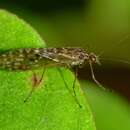en
names in breadcrumbs


Nannochoristidae is a family of scorpionflies with many unusual traits. It is a tiny, relict family with a single extant genus, Nannochorista, with eight species occurring in New Zealand, southeastern Australia, Tasmania, Argentina and Chile. Due to the group's distinctiveness from other scorpionflies, it is sometimes placed in its own order, the Nannomecoptera. Some studies have placed them as the closest living relatives of fleas.[1] Most mecopteran larvae are eruciform, or shaped like caterpillars. Nannochoristid larvae, however, are elateriform, and have elongated and slender bodies. The larvae are aquatic, which is unique among mecopterans. The larvae are predatory, hunting on the beds of shallow streams, primarily on the larvae of aquatic Diptera like chironomids.[2]
Fossils indicate that Nannochoristidae formerly had a wider distribution, being present in the Northern Hemisphere during the Jurassic and Early Cretaceous.[3]
Some research suggests the nannochoristids are the only holometabolous insects with true larval compound eyes.[4] All other eyed larvae have stemmata, which are structurally different from adult compound eyes with ommatidia. This is unusual, since most adult features are present as imaginal discs in larvae and not formed until pupation. The presence of compound eyes in nannochoristid larvae suggests the timing of the development of adult features can be initiated earlier in development, which has important implications for insect evolutionary development.
The cladogram of external relationships, based on a 2008 DNA and protein analysis, shows the family as a clade, sister to the Siphonaptera (fleas) and rest of Mecoptera, and more distantly related to the Diptera (true flies) and Mecoptera (scorpionflies).[5][6][7][8]
Panzygothoraca Panorpida AntliophoraDiptera (true flies) 
Nannochoristidae
Mecoptera (scorpionflies, hangingflies) (exc. Boreidae & Nannochoristidae)
Boreidae (snow scorpionflies) 
Siphonaptera (fleas) 
Trichoptera (caddisflies) ![]()
Lepidoptera (butterflies and moths) ![]()
Hymenoptera (sawflies, wasps, ants, bees) 
A more recent study in 2021 found Nannochoristidae to be the sister group to fleas, with strong support.[1]
AntliophoraDiptera (true flies) 
Boreidae (snow scorpionflies, 30 spp.) 
Nannochoristidae (southern scorpionflies, 8 spp.)
Siphonaptera (fleas, 2500 spp.) 
Pistillifera (scorpionflies, hangingflies, 400 spp.) 
After Cao et al. 2022.[9]
Nannochoristidae is a family of scorpionflies with many unusual traits. It is a tiny, relict family with a single extant genus, Nannochorista, with eight species occurring in New Zealand, southeastern Australia, Tasmania, Argentina and Chile. Due to the group's distinctiveness from other scorpionflies, it is sometimes placed in its own order, the Nannomecoptera. Some studies have placed them as the closest living relatives of fleas. Most mecopteran larvae are eruciform, or shaped like caterpillars. Nannochoristid larvae, however, are elateriform, and have elongated and slender bodies. The larvae are aquatic, which is unique among mecopterans. The larvae are predatory, hunting on the beds of shallow streams, primarily on the larvae of aquatic Diptera like chironomids.
Fossils indicate that Nannochoristidae formerly had a wider distribution, being present in the Northern Hemisphere during the Jurassic and Early Cretaceous.
Some research suggests the nannochoristids are the only holometabolous insects with true larval compound eyes. All other eyed larvae have stemmata, which are structurally different from adult compound eyes with ommatidia. This is unusual, since most adult features are present as imaginal discs in larvae and not formed until pupation. The presence of compound eyes in nannochoristid larvae suggests the timing of the development of adult features can be initiated earlier in development, which has important implications for insect evolutionary development.